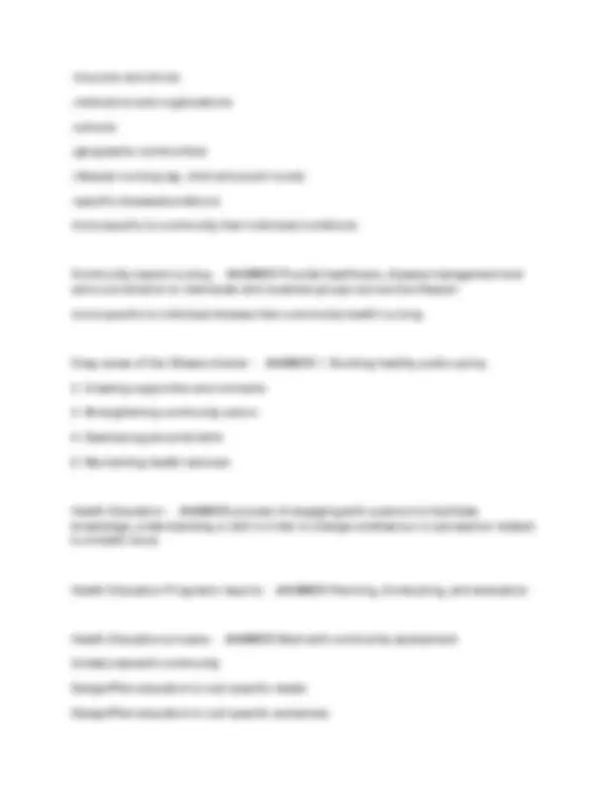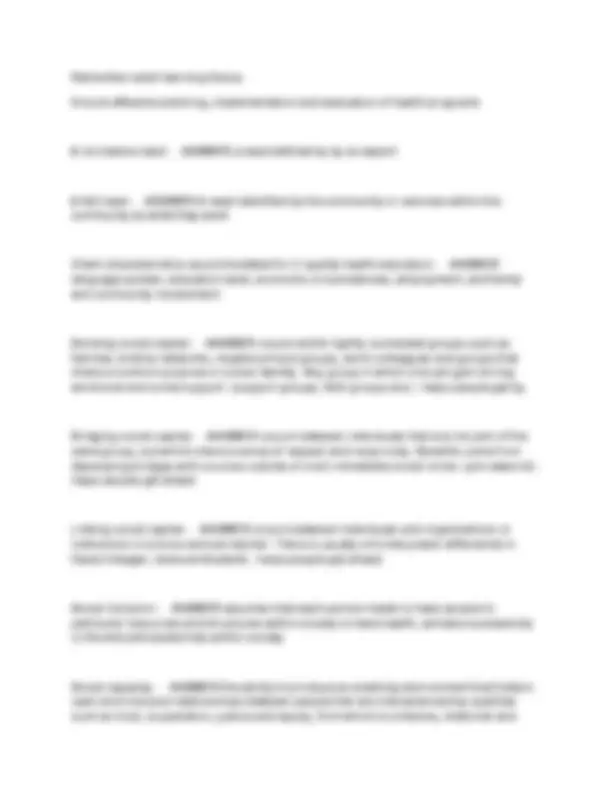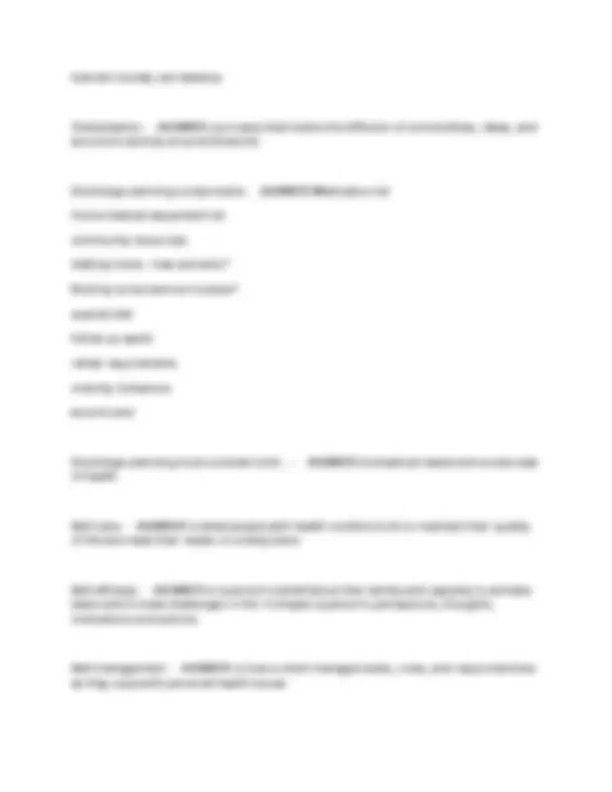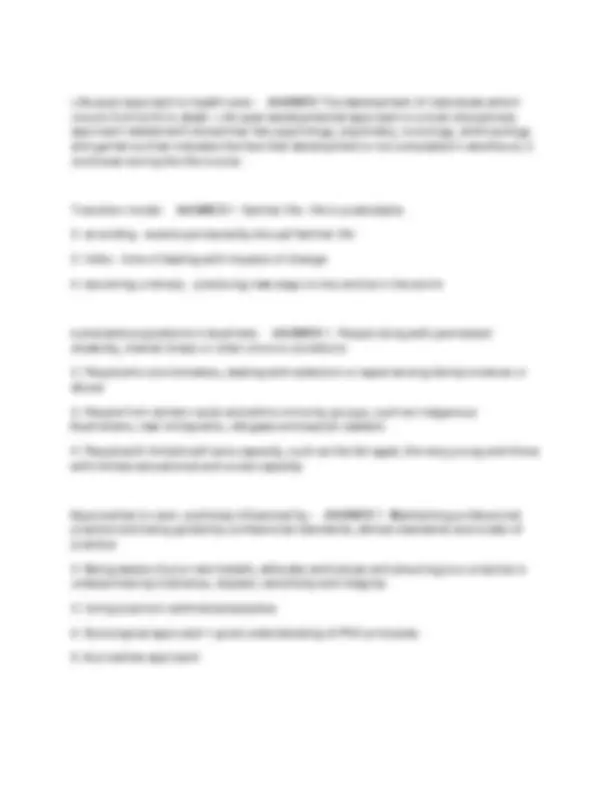






Study with the several resources on Docsity

Earn points by helping other students or get them with a premium plan


Prepare for your exams
Study with the several resources on Docsity

Earn points to download
Earn points by helping other students or get them with a premium plan
Community
Ask the community for help and clear up your study doubts
Discover the best universities in your country according to Docsity users
Free resources
Download our free guides on studying techniques, anxiety management strategies, and thesis advice from Docsity tutors
A comprehensive overview of key concepts and principles related to health and wellbeing in the context of community nursing. It explores various models of health, including the biomedical and social models, and delves into the social determinants of health, social exclusion, and social capital. The document also examines the role of community health nursing, health education, and family assessment in promoting health and wellbeing within communities. It highlights the importance of cultural competence, self-determination, and self-management in providing effective healthcare services.
Typology: Exams
1 / 8

This page cannot be seen from the preview
Don't miss anything!





Dimensions of health - ANSWER Physical, mental and social
Social determinants of health - ANSWER The conditions in which we live and work which affect our health
Social gradient of health - ANSWER refers to the fact that inequalities in population health status are related to inequalities in social status
cycle of poverty - ANSWER less access to food, safe water, healthcare and school -> hunger, poor sanitation, lack of education -> few work opportunities, disease, malnutrition, death -> depleted and unskilled workforce, unemployment -> low family income ->rpt
Social exclusion - ANSWER Social disadvantage, lack of resources, lack of opportunity. Multifactorial problems lead to social exclusion (eg. unemployment, discrimination, inadequate skills etc) - prevent a person engaging in and benefiting from their community
Social capital - ANSWER Benefits gained by social connectiveness and bonds, physical and emotional wellbeing Communities which demonstrate trust, respect and cooperation demonstrate this
Biomedical model of health - ANSWER Focus on the physical and biological aspects of disease and illness Medical model of care practiced by doctors and health care professionals Emphasis on diagnosis and treating individuals separate from their lifestyle/living conditions The person is expected to take on a passive role whilst the Dr 'fixes' the health condition
Social model of health - ANSWER Framework used in community health Addresses the broader influences on health (social, cultural, environmental, economic factors) rather than disease and injury Community based approach to prevent disease and illness Focus on policies, education and health promotion
5 key principles of the social model of health - ANSWER 1. Address the broader determinants of health
Primary health care - ANSWER o First level of contract o Incorporates personal care, health promotion and prevention of illness o Incorporates community development (equity, access, empowerment, community self-determination, inter-sectoral collaboration) o Acknowledges social, cultural and political determinants of health
Community health levels - ANSWER person->family->local community->Australian population->global population
Community Nursing roles - ANSWER Community health nursing Community based nursing
Community Health Nursing - ANSWER Provide nursing focused on promoting health and wellness of communities and population. work with:
Remember adult learning theory Ensure effective planning, implementation and evaluation of health programs
A normative need - ANSWER a need defined by by an expert
A felt need - ANSWER A need identified by the community or services within the community as what they want
Client characteristics accommodated for in quality health education - ANSWER language spoken, education level, economic circumstances, employment, and family and community involvement
Bonding social capital - ANSWER occurs within tightly connected groups such as families, kinship networks, neighbourhood groups, work colleagues and groups that share a common purpose or social identity. Any group in which one can gain strong emotional and social support. (support groups, faith groups etc) - helps people get by
Bridging social capital - ANSWER occurs between individuals that are not part of the same group, but which share a sense of respect and reciprocity. Benefits come from developing bridges with sources outside of one's immediate social circle. (job network) - helps people get ahead
Linking social capital - ANSWER occurs between individuals and organisations or institutions in a more vertical manner. There is usually a formal power differential in these linkages. (lecturer/student) - helps people get ahead
Social inclusion - ANSWER assumes that each person needs to have access to particular resources and structures within society to have health, achieve successfully in life and participate fully within society
Social capacity - ANSWER the ability to produce an enabling environment that fosters open and inclusive relationships between people that are characterised by qualities such as trust, cooperation, justice and equity, from which a cohesive, relational and
tolerant society can develop
Globalisation - ANSWER a process that marks the diffusion of commodities, ideas, and economic activity around the world
Discharge planning components - ANSWER Medication list Home medical equipment list community resources Getting home - how and who? Visiting nurse service in place? special diet follow-up appts rehab requirements mobility limitations wound care
Discharge planning must consider both... - ANSWER biomedical needs and social view of health
Self-care - ANSWER Is what people with health conditions do to maintain their quality of life and meet their needs on a daily basis.
Self-efficacy - ANSWER is a person's belief about their ability and capacity to achieve tasks and to meet challenges in life. It shapes a person's perceptions, thoughts, motivations and actions.
Self-management - ANSWER is how a client manages tasks, roles, and responsibilities as they cope with personal health issues
Mandatory reporting - ANSWER - National framework
Self-determination - ANSWER 1. the power or ability to make a decision for oneself without influence from outside
Self-advocacy - ANSWER The action of representing oneself or one's views or interests
Cultural competence - ANSWER The ability to understand, communicate with and effectively interact with people across cultures. Cultural competence encompasses. being aware of one's own world view. developing positive attitudes towards cultural differences. gaining knowledge of different cultural practices and world views.
Cultural safety - ANSWER An environment that is spiritually, socially and emotionally safe, as well as physically safe for people; where there is no assault challenge or denial of their identity, of who they are and what they need.
health literacy - ANSWER The degree to which individuals have the capacity to obtain, process, and understand basic health information and services needed to make appropriate health decisions.
Life-span approach to health care - ANSWER The development of individuals which occurs from birth to death. Life span developmental approach is a multi-disciplinary approach related with disciplines like psychology, psychiatry, sociology, anthropology and geriatrics that indicates the fact that development is not completed in adulthood, it continues during the life course.
Transition model - ANSWER 1. familiar life - life is predictable
vulnerable populations in Australia - ANSWER 1. People living with permanent disability, mental illness or other chronic conditions
Approaches to care: positively influenced by - ANSWER 1. Maintaining professional practice and being guided by professional standards, ethical standards and codes of practice